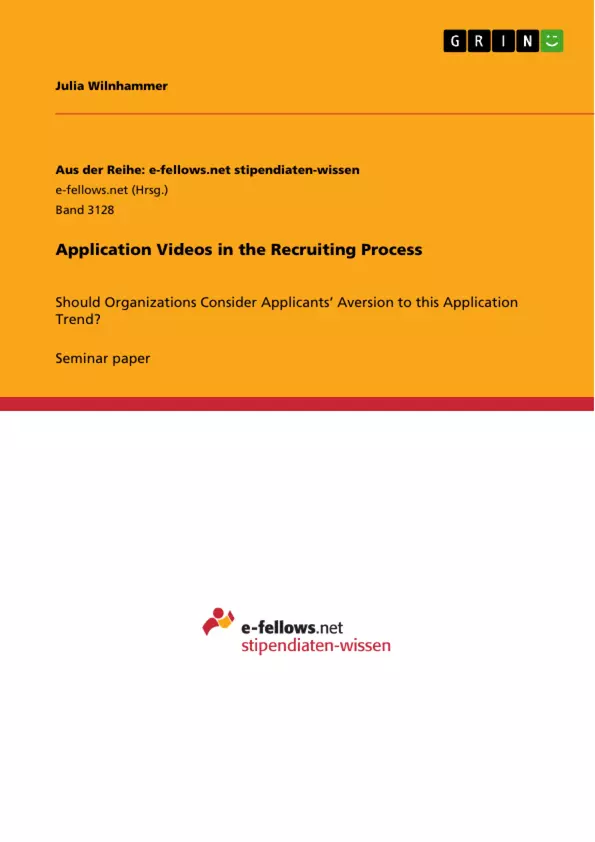New forms of applications are emerging with the introduction of image-based communication
in the application process. The trend of application videos hast the potential to reduce costs and
risks for organizations among other considerable opportunities, but this application type has not
been popularly implemented by organizations in their recruiting processes yet. However, there
is practically no scientific research on the use of these videos and whether (and to what degree)
applicants accept this application trend. For this term paper, applicants’ aversion to application
videos and potentially related constructs are empirically examined via an online survey with a
sample of students from all over Germany. Results show relatively high aversion to application
videos among the participants but there are differences depending on the students’ fields of
study. Correlation analysis reveals a weak negative correlation between video technology ac-
ceptance and aversion to application videos. Furthermore, aversion to application videos is
positively correlated with participants’ risk aversion whereas no significant correlation with job
application experience was be found. This term paper emphasizes that applicants’ aversion to
application videos is substantial and should therefore be carefully considered in the adoption
of this trend. It represents continuation of research on e-selection solutions and builds a sound
starting point for future research on application videos.
Inhaltsverzeichnis (Table of Contents)
- 1 Introduction
- 2 Theoretical Background
- 2.1 Definition of Key Terms and Concepts
- 2.1.1 The Recruiting Process
- 2.1.2 Digital Transformation of HR and Recruiting
- 2.1.3 Electronic Selection Systems
- 2.1.4 Videos in the Electronic Selection Process
- 2.2 Application Videos
- 2.2.1 Opportunities for Organizations and Applicants
- 2.2.2 Applicants' Reservations and Threats for Organizations
- 2.3 Derivation of Hypotheses
- 2.1 Definition of Key Terms and Concepts
- 3 Method and Data
- 3.1 Data Collection and Measures
- 3.2 Sample
- 4 Results
- 5 Discussion
Zielsetzung und Themenschwerpunkte (Objectives and Key Themes)
This term paper examines the use of application videos in the recruiting process and specifically investigates applicants' aversion to this new application trend. It aims to contribute to the understanding of the potential benefits and challenges associated with video-based applications in the context of digital transformation in HR and recruiting.
- Applicants' aversion to application videos
- The impact of video technology acceptance on aversion to application videos
- The relationship between risk aversion and aversion to application videos
- The role of job application experience in applicants' attitudes towards application videos
- The implications of these findings for organizations adopting application video technology
Zusammenfassung der Kapitel (Chapter Summaries)
- Chapter 1: Introduction This chapter introduces the context of the term paper, emphasizing the importance of attracting talents and the role of recruiting and selection in achieving organizational success. It highlights the increasing use of digital recruiting tools, particularly electronic application systems, and introduces the emerging trend of application videos.
- Chapter 2: Theoretical Background This chapter provides a comprehensive definition of key terms and concepts related to the recruiting process, digital transformation in HR and recruiting, and electronic selection systems. It delves into the use of videos in the electronic selection process and specifically examines the opportunities and challenges posed by application videos for both organizations and applicants.
- Chapter 3: Method and Data This chapter outlines the methodology and data collection process used in the study. It describes the survey instrument and the sample of students from all over Germany who participated in the study.
- Chapter 4: Results This chapter presents the findings of the empirical study, examining applicants' aversion to application videos, the influence of video technology acceptance, risk aversion, and job application experience on this aversion.
- Chapter 5: Discussion This chapter interprets the findings of the study, discussing their implications for organizations considering the adoption of application videos in their recruiting processes. It examines the potential benefits and drawbacks of this trend and suggests future research directions.
Schlüsselwörter (Keywords)
This term paper focuses on the use of application videos in the recruiting process and investigates the factors influencing applicants' aversion to this trend. Key themes explored include video technology acceptance, risk aversion, job application experience, and the impact of these factors on applicants' attitudes towards application videos. The research contributes to the understanding of e-selection solutions and provides insights for organizations considering the adoption of application videos in their recruiting strategies.
- Citation du texte
- Julia Wilnhammer (Auteur), 2018, Application Videos in the Recruiting Process, Munich, GRIN Verlag, https://www.grin.com/document/491729



